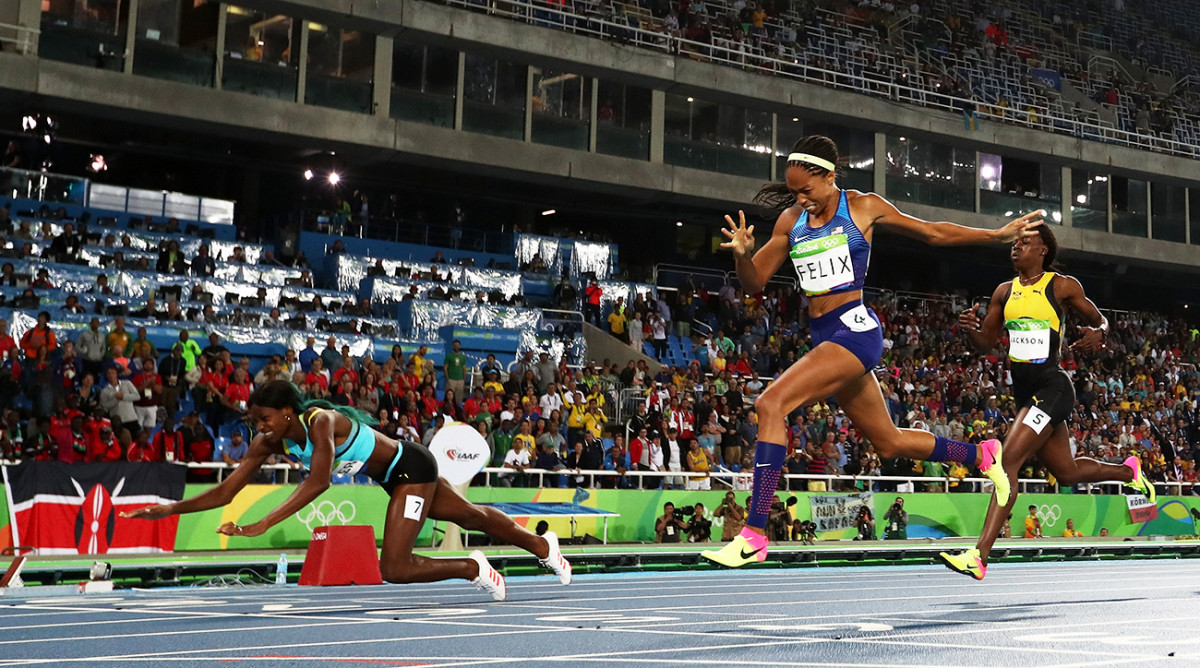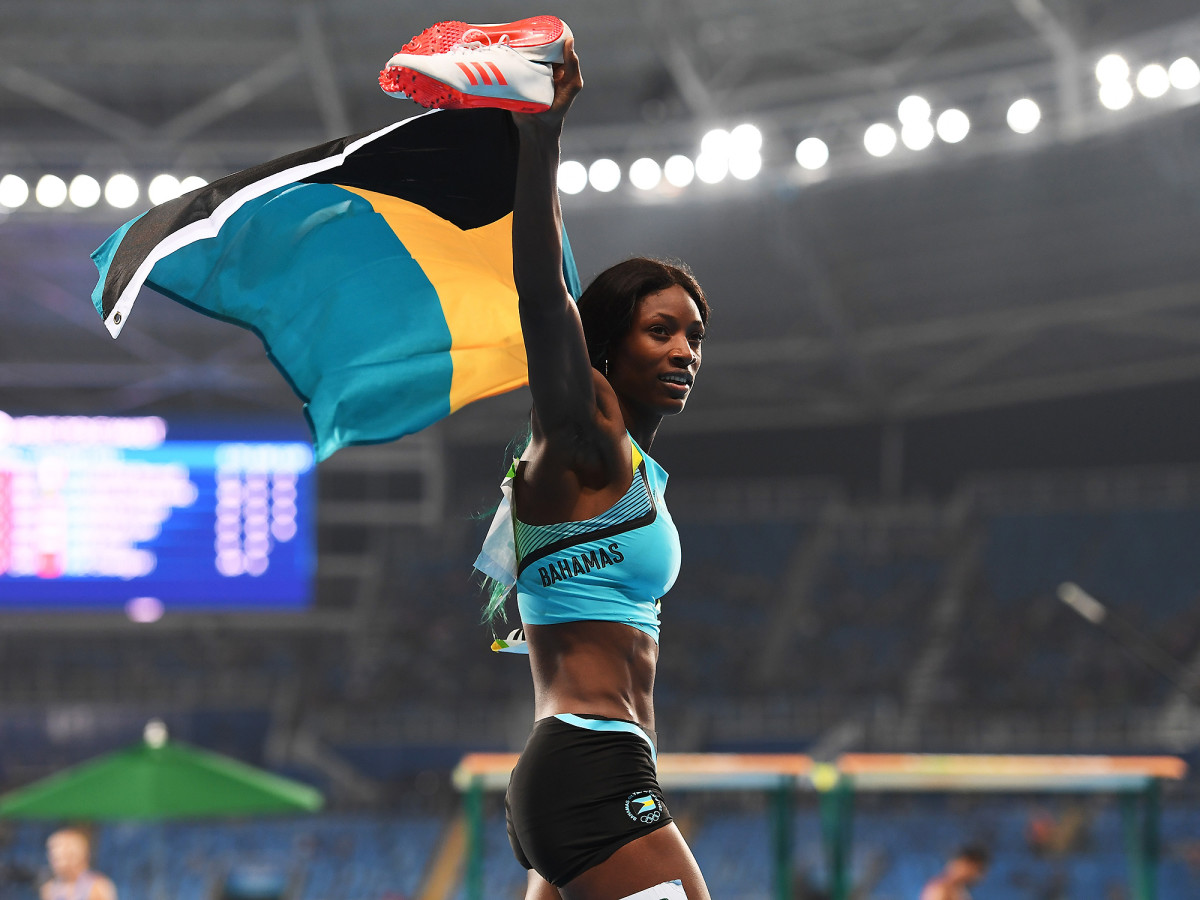Shaunae Miller's golden dive may be controversial, but it wasn't illegal

RIO DE JANEIRO — It was always expected that diving would enter the public discussion during the fortnight of the Olympic Games here in Rio. What’s surprising is that the discussion centers not on people plunging into water, but rather on one woman who desperately tried to reach the finish line on the dry land of a blue running track at the Olympic Stadium.
The incident occurred on Monday night in the final of the women’s 400 meters. Shaunae Miller, 22, a former University of Georgia sprinter competing for the Bahamas, running nearly blind from far outside in lane seven, forged a substantial lead entering the final 100 meters, but then began to tire. American Allyson Felix, 30, cut into Miller’s lead and appeared ready to win at the line, when Miller seemed to throw her body across the finish line. Both athletes lay on the ground for 15 seconds until the scoreboard showed that Miller had won the race with an official time of 49.44 seconds and that Felix had finished second in 49.51 seconds.
The outcome was dramatic and visually stunning. But it was immediately branded as “controversial” on many forms of social media, not uncommon at the Olympic Games, where a wide audience is exposed to the quirks of sports that they don’t often consume. The debate has nudged up against ugly, with suggestions that Miller’s dive was unfair or unethical. And that, too, has engendered blowback.
“It has pissed me off greatly to see people saying it wasn’t ethical or [that it was] a cheap move,” NBC analyst and four-time Olympic sprint medalist Ato Boldon told SI.com. “I’m trying to stay off social media about it because I’ll go off. [Diving] happens all the time, and it just feels like Americans are pissed because Allyson lost. No one is a bigger Allyson fan [than I am], but she lost. Live with it.”
Shaunae Miller wins 400 meters after diving across finish line, upsets Allyson Felix
The most important truth here: Diving across the finish line is 100 percent legal. Any form of getting there is fair. From the track and field rule book, Rule 164: “The athletes shall be placed in the order in which any part of their bodies (i.e. torso, as distinguished from the head, neck, arms, legs, hands or feet) reaches the vertical plane of the near edge of the finish line as defined above.”
From his home in Manhattan, Kansas, Roger Jennings, 49, watched Monday night’s final. Jennings is the chief finish line judge for Flash Results, the company that oversees most major U.S. meets—including the Olympics Trials—and also many international meets. Another company with similar technology is working the Olympic Games. Jennings was the judge on the controversial Felix-Jeneba Tarmoh dead heat the 2012 Olympic Trials. When contacted by SI.com Tuesday, Jennings pulled up the official finish photo from Monday night’s race. While on the phone, Jennings said, “Yup, that’s a good read. You can clearly see that Miller’s torso, collarbone area is on the line ahead of Felix. It’s actually a pretty substantial margin. Seven-hundredths. Not that close.”
Jennings explained that the finish photo is captured by a digital camera and that the plane of the finish extends from the ground upward above the height of the athletes. “You could win a race right on the ground,” said Jennings.

The defeat was bitter for Felix on multiple levels. She had started this season hoping to win both the 200 meters and 400 meters in Rio, but a spring ankle injury stunted her training. She made the Olympic team in the 400 meters, but not in the 200. In that 200-meter race, she was beaten out for third place by Jenna Prandini, who took the spot by diving, or falling, across the line.
Diving to the line, while legal within the rules, is generally discouraged by coaches, because it’s a usually a slower and less efficient means of reaching the line. “Legal, but not a smart thing to rely on,” said Dan Pfaff, a veteran sprint coach who mentored 1996 Olympic 100-meter champion Donovan Bailey, and others.
According to Clyde Hart, who coached Olympic 400-meter gold medalists Michael Johnson and Jeremy Wariner, the key is not diving. “We coach our athletes to keep their feet on the ground, keep their composure, and drive their upper body across the line,” said Hart. “You want to lean. You have to lean. But you want to keep your feet on the ground.”
Boldon, who also coaches several elite sprinters, said, “[Diving is] usually not a good idea. It kills your momentum. And usually doesn’t achieve the desired result.”
Sports Illustrated brings the stars of the Rio Olympics together for exclusive cover shoot
But sometimes it does. There are several examples in recent track history of dramatic dives earning places on Olympic teams or actual Olympic medals:
• One of the most dramatic races at the 2008 U.S. Olympic trials was the 800 meters, contested at dusk on a Monday night before a packed house at Hayward Field in Eugene, Oregon. In that race, Nick Symmonds and Andrew Wheating kicked to first and second place and then Christian Smith sprinted up inside a dying Khadevis Robinson and tumbled across the line to grab the third spot on the Olympic team.
• At the 2008 Olympics in Beijing, U.S. 400-meter runner David Neville, fighting lactic acid while also running blind in lane eight, dove across the line to secure the bronze medal by .04 seconds. The runner Neville beat out was Chris Brown, who like Shaunae Miller, is from the Bahamas. “Did Bahamians say Neville cheated?” asked Boldon. Apparently they did not.
• In July, Prandini beat out Felix with a dive in the 200 meters and also Brenda Martinez beat out Amanda Eccleston, as both runners dove over the finish line.
“You see dives all the time,” said Jennings, who officiates hundreds of meets every year. “You see way more with younger runners, like high school and college. You don’t see it quite as often with professional runners because, despite the exception, divers usually lose. They don’t win the race.”
After the race, Miller did not openly cop to diving to the line. “It all just sort of happened,” said Miller. “The only thing I was thinking was, I have to get this gold medal. My legs are getting heavy. It all just kind of happened. It all went blank and then I was lying on the ground.” On replay, it appears that 30 meters from the finish, Felix was going to roll past Miller, but then Felix began to tie up, as well. Miller appears to begin leaning about three strides from the finish, and that lean becomes full lay-out across the line. “Shaunae is so tall that it worked,” said Boldon. (Miller is 6' 1" to Felix’s 5' 6".)

This fits with the experience described by the coaches interviewed by SI.com. “Her legs were failing,” said Pfaff. “Stride was behind her. Obvious stumbling gait. When that happens, instincts to get there take over.”
Hart said, “Fatigue plays a big factor. I think Shaunae just ran out of gas. When that happens you do anything you can to get yourself across the finish line. Then she probably started leaning a step or two early and she wound up on the ground.”
Boldon: “Half desperation and half just running out of legs.”
It’s always possible that IAAF’s technical committee could rethink the finish rule and outlaw diving, but IAAF spokeswoman Anna Legnani noted that such a change would require judging an athletes’ intent. Was the runner diving or simply exhausted and staggering forward?
“On one hand,” said Legnani, “The IAAF is continually reevaluating its rules, so there is a possibility this may come up for discussion in the Technical Committee meeting and possibly trigger a rule change proposal. However, determining intention would be crucial and very difficult to assess.”
For Michael Phelps, Rio marks the end of storied career and transition to new life
Determining intent would not be unprecedented, but certainly challenging. Legnani points out that Rule 168.7b allows that an athlete can be disqualified from a hurdles race if, in the opinion of the referee, he deliberately knocks down a hurdle. Determining whether a tired athlete purposely or accidently fell across the finish line would be more difficult.
“This situation is probably more difficult to assess,” said Legnani. “I personally also felt it was more a desperate dip than a deliberate dive.”
This is certain: As long as there are track races, there will be exhausted athletes, and as long as there are exhausted athletes, there will be dives to the finish. Those dives will be dramatic and, most often, not controversial. It remains a vital and compelling part of the sport.
